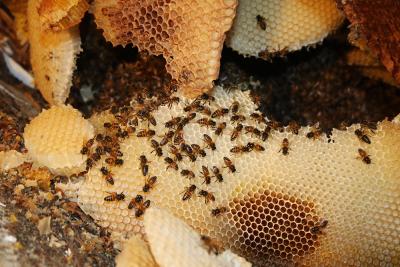Save the Bees

We had known for a while that we had honeybees in the attic. But the way things are in The Star’s century-old Main Street building, it was really no big deal. Until roofers exposed their sprawling hive last week, the bees never really bothered anybody as they came and went from a gap in the soffit high above the sidewalk. In fact, the only time they had any impact whatsoever on the ground floor was one hot summer’s day when a thin trickle of honey appeared on the inside of one of our front windows, hardly enough to spread on toast.
Honeybees are in trouble due to something known as colony collapse disorder, as well as a variety of other factors. Reports of losses of 30 percent or more a year by beekeepers are common. But bees are an essential part of the food web; as much as $20 billion worth of the food crop in North America is dependent on the relentless pollination these social and generally peaceable creatures perform. Given this, it is cruel and wholly counterproductive to call in an exterminator at the first sign of a swarm, as many do in fear and ignorance.
So our first call when the roofers alerted us was to Dell Cullum, a well-known East Hampton photographer and wildlife relocation expert. After taking a look, Dell phoned East Hampton Town Trustee Debbie Klughers, who also happens to be a beekeeper. Suited in protective mesh to keep bees out of her hair and off her face, but with bare hands, Debbie, with a little help from some Star staff members, methodically removed sections of hive from between the rafters, placing the milling bees into a wooden box for transit to their new home, while Dell recorded it all on video.
There was elation when they spotted the colony’s queen, which, to us, looked like an oversized bee. Debbie explained that the brood clustered around the queen to keep her warm and that if we were able to get her into the transportation box, the rest would go along placidly. It took a bit over an hour to complete the task. During this, bees buzzed everywhere in the room, crawling on our hands and arms, but only one person, Debbie, was stung, and just once, on a finger.
As spring’s warmth encourages honeybees out of their winter torpor, people will undoubtedly see their swarms. Many beekeepers will perform hive rescues, and if they do not, will know someone who will. Lethal methods of control should be the very last resort. The bees aren’t looking to harm anyone, and right now, they can use all the help they can get.
WATCH: What To Do When You Have Bees in the Attic? Call a Bee Rescuer
